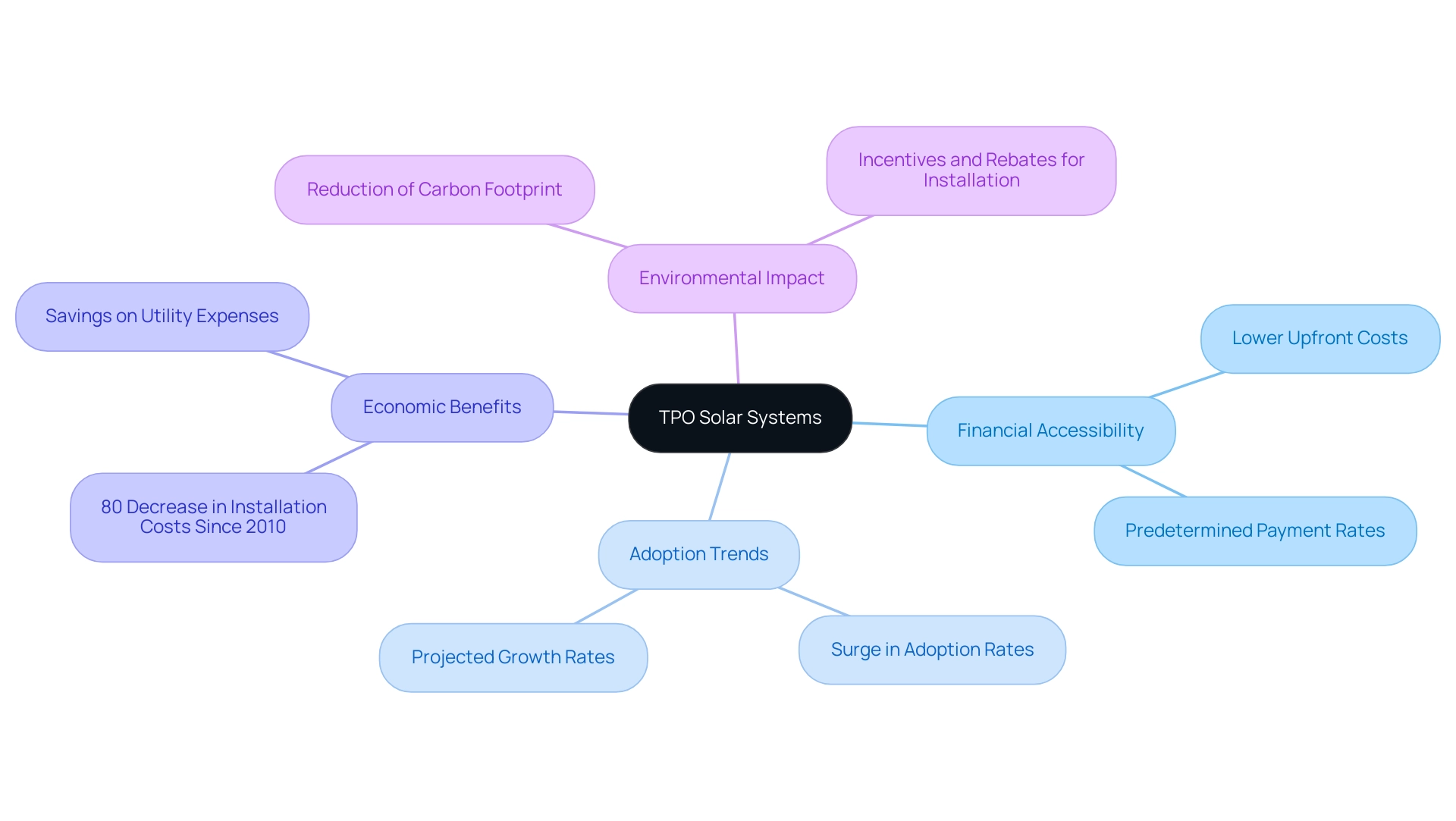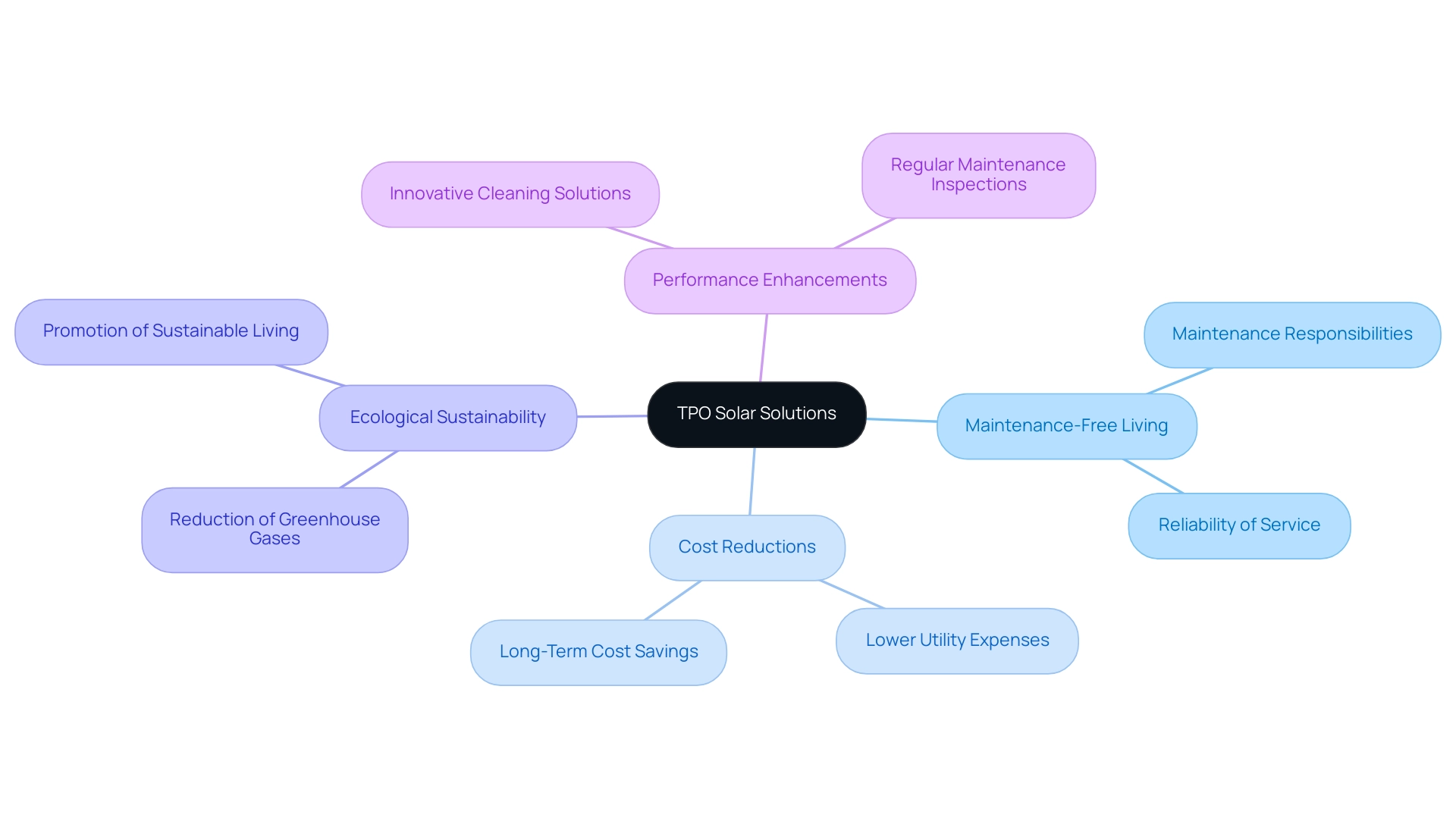Overview
The top benefits of TPO solar systems for eco-conscious homeowners include significant cost savings, accessibility to renewable energy without substantial upfront investments, and a reduction in maintenance responsibilities. The article emphasizes that TPO systems lower initial expenses through third-party ownership, democratize access to solar energy for diverse socioeconomic groups, and provide hassle-free solutions, thereby making sustainable energy more attainable and appealing for homeowners committed to environmental stewardship.
Introduction
In an age where sustainability is more than just a trend, Third-Party Ownership (TPO) solar systems are revolutionizing the way homeowners access renewable energy. This innovative model allows individuals to harness the power of the sun without the hefty upfront investment typically associated with solar installations.
By partnering with third-party providers, homeowners can enjoy the benefits of solar energy—such as reduced utility bills and a smaller carbon footprint—while leaving the complexities of ownership, maintenance, and repairs to the experts.
As the demand for eco-friendly solutions grows, TPO systems are emerging as a viable option for a diverse range of households, particularly in communities that have traditionally faced barriers to solar adoption.
With projections indicating a significant rise in TPO deployment, understanding the multifaceted advantages of these systems is essential for anyone looking to make informed decisions about their energy future.
Understanding TPO Solar Systems: A Sustainable Choice
TPO solar photovoltaic installations represent a transformative approach to sustainable power, allowing eco-conscious residents to harness sunlight without the burden of significant upfront expenses. In a TPO solar arrangement, a third-party company owns and maintains the power setup, while the homeowner pays for the output produced at a predetermined rate. This model not only enhances financial accessibility but aligns with the growing trend of utilizing renewable resources, especially appealing to those looking to reduce their carbon footprint.
Recent developments indicate a surge in TPO solar adoption, with projections showing significant increases in deployment rates over the next few years. Significantly, installation expenses for photovoltaic technology have dropped by 80% since 2010, reinforcing the economic advantages of TPO solar arrangements. Furthermore, predictions for residential photovoltaic power usage in the U.S. from 2022 to 2050 indicate an increasing dependence on renewable resources, which is essential for residents pursuing sustainable options.
As Ara Agopian, founder and CEO of Solar Insure, states, ‘The evolution of TPO solar systems is pivotal for individuals seeking sustainable solutions without the complications of ownership.’ Moreover, comprehending the advantages of heating systems—like their capacity to raise water to temperatures reaching 400 degrees Fahrenheit, significant savings on utility expenses, and possible incentives or rebates for installation—can additionally enable residents to make informed choices about their power sources. This comprehensive method not only emphasizes the financial and environmental advantages of renewable energy solutions but also promotes an equitable access initiative for all residents, reinforcing the significance of shifting to sustainable energy practices.
Cost Savings: How TPO Solar Systems Reduce Upfront Investment
One of the most compelling benefits of TPO energy solutions is their capacity to considerably lower initial expenses for environmentally aware homeowners. This innovative financial model allows individuals to bypass the substantial expenses typically associated with purchasing and installing photovoltaic panels outright. Instead, they can choose a lease or a power purchase agreement (PPA), which allows them to pay for the electricity produced by the setup at rates often lower than their current utility expenses.
In markets such as Arizona and Colorado, TPO energy systems have captured over 80% of the residential market, demonstrating their effectiveness and appeal. According to Carolyn Davidson, our sample data suggest that PPA contracts generally cost more than leases, a trend that persists even when contracts are categorized by the amount of upfront payment. This financial model not only improves access to renewable power but also enables property owners to begin reducing their utility costs promptly, thus enhancing their overall financial health.
Furthermore, renewable energy subsidies can play a crucial role in increasing [aggregate electricity demand](https://dspace.mit.edu/bitstream/handle/1721.1/130068/Information Searching in the Residential Solar PV Market – Final Submission.pdf?sequence=2&isAllowed=y) and reducing potential backfire effects, as highlighted in the case study titled [‘Modeling Electricity Demand](https://dspace.mit.edu/bitstream/handle/1721.1/130068/Information Searching in the Residential Solar PV Market – Final Submission.pdf?sequence=2&isAllowed=y) and Subsidy Effects.’ This research demonstrates how financial assistance for photovoltaic power can affect residential electricity usage trends, suggesting that [although reduced costs may result](https://dspace.mit.edu/bitstream/handle/1721.1/130068/Information Searching in the Residential Solar PV Market – Final Submission.pdf?sequence=2&isAllowed=y) in higher total electricity consumption, they also provide a chance for residents to embrace renewable alternatives. A thorough comparison shows that while conventional electricity expenses keep increasing, TPO renewable energy solutions provide a consistent and frequently reduced cost choice, making them an appealing option for property owners.
For Long Beach tenants, accessing renewable power solutions may involve community programs or collaborations with local providers, ensuring that they too can benefit from sustainable resources without the need for rooftop installations. With TPO photovoltaic installations, the transition towards renewable sources becomes not only an environmentally responsible option but also a wise financial approach, especially for eco-aware residents. Recent articles have also examined the financial advantages of power purchase agreements, reinforcing their value as a sustainable investment.
Accessibility: Making Solar Energy Attainable for All
TPO solar systems are crucial in democratizing access to renewable power for homeowners, especially renters in Long Beach, who may struggle with the significant upfront costs associated with complete installations. By alleviating the burden of significant upfront payments, TPO solar arrangements facilitate broader adoption of solar solutions among diverse socioeconomic groups, making eco-friendly power more accessible. This model is particularly advantageous for low-income communities, where financial limitations often restrict access to renewable technologies.
Moreover, TPO solar solutions can connect with Tesla home chargers and battery choices, enhancing the overall power efficiency and sustainability of households. Recent reports indicate that TPO solar systems not only promote inclusivity but also provide sustainable power alternatives without financial strain. Consequently, an estimated 16.8 million U.S. households are projected to embrace renewable technology by 2032, highlighting the clear expansion in harnessing sunlight.
Ryan Suchsland, an experienced residential consultant, highlights that these agreements signify a transformative move toward greater fairness in access to power. Moreover, prominent residential renewable companies such as Sunrun and Tesla have reported substantial revenues, with Sunrun generating approximately 2.3 billion U.S. dollars and Tesla’s power segment exceeding six billion U.S. dollars in 2023. This financial viability highlights the potential of TPO solar systems to encourage sustainable practices across diverse demographics, paving the way for a greener, more inclusive future in energy utilization.
Long Beach renters can also benefit from various government programs that provide financial incentives for renewable energy adoption, as well as cleaning services to maintain panels, ensuring optimal performance. With these resources, renters can seamlessly incorporate renewable energy solutions into their lifestyles, reaping economic and environmental benefits while contributing to a sustainable future.
Maintenance-Free Living: Hassle-Free Solar Solutions
One of the most compelling benefits of TPO solar (Third Party Ownership) energy solutions is the maintenance-free lifestyle they provide to property owners. With the third-party provider accountable for ownership and management, maintenance and repair tasks rest solely on their shoulders, enabling environmentally-minded homeowners to enjoy the advantages of renewable energy without the onerous responsibilities usually linked to upkeep. These energy arrays function by transforming sunlight into electricity via photovoltaic cells, which are mounted on the roof.
Furthermore, akin to water heaters that provide substantial cost reductions and decreased dependence on non-renewable resources, these installations aid in reducing utility expenses while encouraging ecological sustainability. Recent insights indicate that well-installed residential energy setups rarely require service calls; when issues do arise, they are often resolved in a single visit, significantly reducing long-term costs. Based on recent statistics, maintenance frequency for well-managed energy setups is remarkably low, further supporting the reliability of TPO solutions.
Innovative cleaning solutions, such as automated cleaning robots or special coatings that repel dirt, can enhance the efficiency and longevity of photovoltaic panels, ensuring they operate at peak performance. As Andrew Santiago fittingly states, ‘By opting for ownership instead of TO, you’re not only investing in renewable energy—you’re investing in quality, reliability, and assurance.’ Regular maintenance inspections and timely repairs by external providers guarantee optimal performance, offering homeowners unmatched reassurance. Furthermore, taking into account the economic and ecological advantages of heating technologies, such as cost savings, job creation, and reduction of greenhouse gases, it is evident that investing in renewable energy enhances property value and promotes sustainable living practices.
Environmental Impact: Contributing to a Greener Planet
TPO solar systems play a pivotal role in mitigating carbon footprints and fostering a sustainable planet. By efficiently utilizing sunlight, homeowners can greatly lessen their reliance on fossil fuels, which are major contributors to greenhouse gas emissions. To ascertain how much power is required for a home, it is crucial to evaluate factors such as consumption, roof size, and local sunlight availability.
This shift not only tackles the pressing issue of climate change but also drives the movement toward a sustainable power future. Indeed, several case studies highlight how households, like one in Southern California, achieved over 70% reduction in utility costs through similar installations, demonstrating the concrete advantages of moving to renewable power. Moreover, choosing the appropriate panel inverter is essential for optimizing power efficiency; homeowners should take into account factors such as:
- inverter type
- efficiency ratings
- compatibility with their installation
With methane releases reaching almost 135 million tons, the need for embracing renewable power sources such as TPO solar is essential, as these technologies can directly aid in reducing greenhouse gas emissions. The Solar Energy Industries Association (SEIA) emphasizes the necessity of comprehensive climate and power legislation to bolster these initiatives, stating that such policies are vital for promoting clean solutions. For eco-conscious homeowners, choosing a TPO solar solution for photovoltaic energy is not merely an investment in efficiency; it represents a dedication to environmental stewardship and a proactive strategy to address climate change, as emphasized by the European Union’s recent 2.5% decrease in emissions linked to effective conservation measures and enhanced renewable generation.
Boosting Property Value: The Long-Term Benefits of TPO Systems
Installing a tpo solar energy solution can significantly increase a property’s market worth. Houses fitted with renewable power systems are progressively regarded as more appealing by prospective purchasers, leading to an average resale value rise of 6.8%, which equates to about $25,000 additional. In Q3 2024, 1.1 GW of residential photovoltaic systems was installed, reflecting a growing interest in energy solutions.
This trend underscores the increasing demand for energy-efficient homes, which promise reduced utility costs and sustainable living. Numerous states offer incentives and tax advantages for photovoltaic systems, boosting their financial attractiveness for prospective property buyers. For instance, homeowners can benefit from federal tax credits that cover a significant percentage of installation costs.
As Powercore Electric highlights, ‘When it comes to covering the cost of your panels, you’ll receive the greatest value if you pay for them upfront in cash.’ Furthermore, choosing advanced inverter technologies such as microinverters or power optimizers can improve performance monitoring and longevity. Reviews from pleased clients emphasize the efficiency of our installations, with one resident declaring, ‘Our utility costs have decreased significantly since placing the panels, and we appreciate knowing we’re supporting a sustainable future.’
With Powercore’s regional knowledge and dedication to unparalleled quality workmanship, investing in a TPO solar energy solution not only provides instant savings during ownership but also enhances enduring value to your property, making it a prudent long-term investment for environmentally aware property owners.
Supporting Local Economies: The Community Benefits of TPO Solar
Choosing TPO solar systems not only offers eco-conscious homeowners substantial energy savings but also plays a vital role in strengthening local economies. Powercore Electric, your leading panel provider in Northern California, offers a range of services including:
- Residential panel installations
- Flexible financing options
Many TPO solar energy providers operate as small, local businesses, making their presence vital for job creation and economic growth within the community.
Experts predict that the energy market is set to triple in size by 2028, underscoring the potential for numerous job opportunities across various sectors supporting renewable technology. However, it is important to recognize the current challenges, such as:
- The depletion of California’s project queue
- Higher financing costs
These challenges have negatively impacted residential energy installations in early 2024. A significant example is Tabco Towers, which has effectively used community energy initiatives to alleviate increasing operating expenses, ultimately assisting in keeping rent affordable for low- and moderate-income residents.
Furthermore, the expansion of the photovoltaic sector generates educational prospects in schools and universities, emphasizing renewable resources and sustainability. By opting for renewable sources, homeowners not only obtain economical solutions but also boost local economies and support sustainable practices. Supporting Powercore Electric and local solar providers cultivates a sense of community and shared responsibility, fostering a sustainable future for all.
Contact Powercore Electric today for your free quote and take the first step towards energy independence.
Conclusion
The rise of Third-Party Ownership (TPO) solar systems marks a significant shift in how homeowners engage with renewable energy. By eliminating the daunting upfront costs associated with solar installations, TPO models empower a diverse range of households to access clean energy solutions. This approach not only enhances financial accessibility but also fosters inclusivity, particularly for low-income communities and renters who might otherwise be excluded from the benefits of solar energy.
Moreover, the maintenance-free aspect of TPO systems alleviates the burdens of ownership, allowing homeowners to enjoy the advantages of solar power without the complexities of upkeep. This convenience, coupled with the environmental benefits of reduced carbon footprints and lower utility bills, positions TPO systems as a compelling choice for those seeking sustainable living options.
As the solar market continues to expand, the positive impact of TPO solar systems on property values and local economies cannot be overlooked. Homeowners not only see an increase in their property’s market value but also contribute to job creation and community growth through their investment in renewable energy.
Ultimately, embracing TPO solar systems represents more than just a financial decision; it is a commitment to a sustainable future. As awareness of the environmental and economic benefits grows, TPO systems will likely play a pivotal role in driving the transition toward widespread adoption of solar energy, ensuring that more households can participate in this crucial movement for a greener planet.




